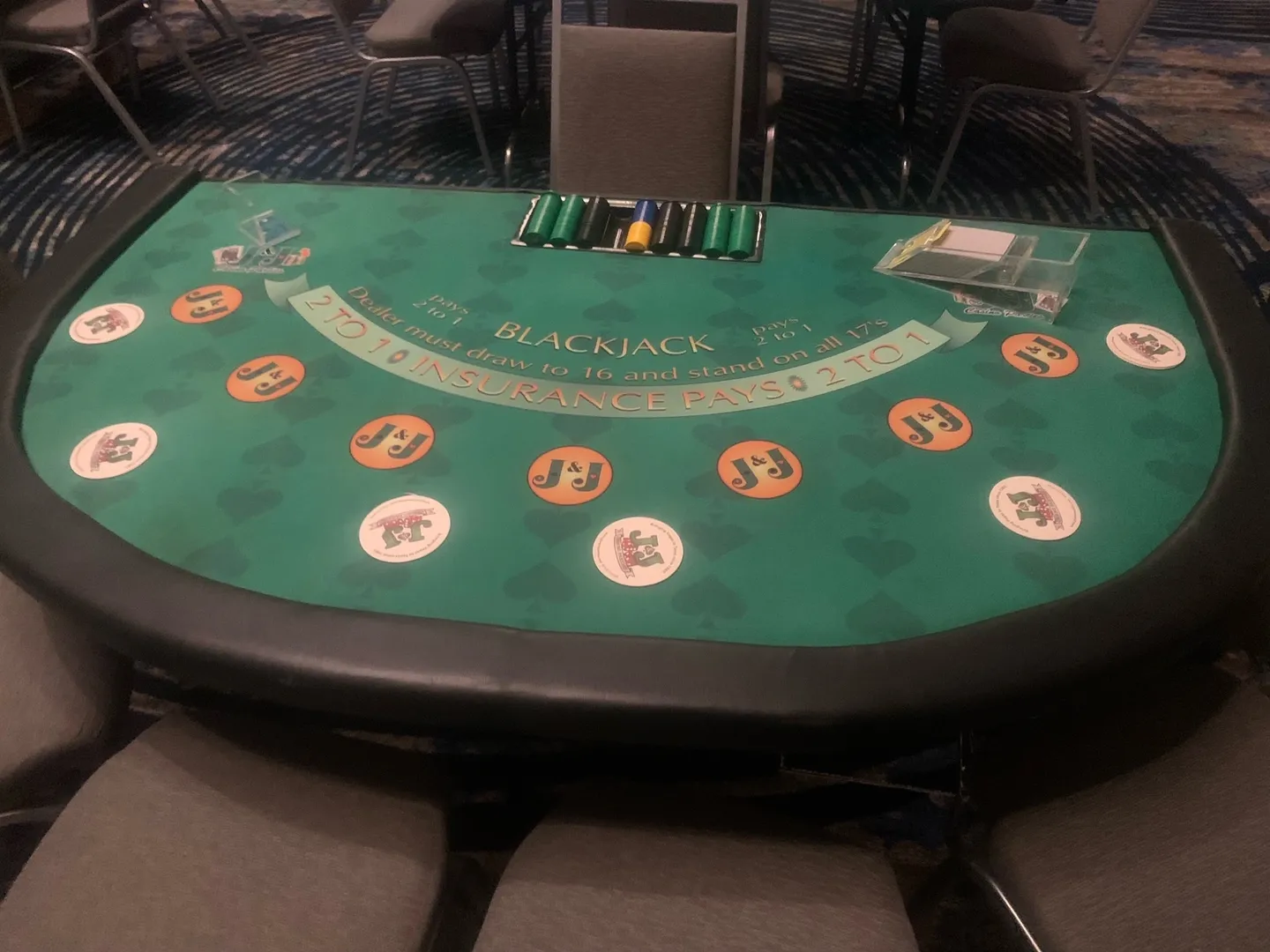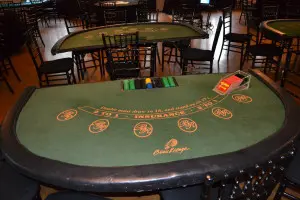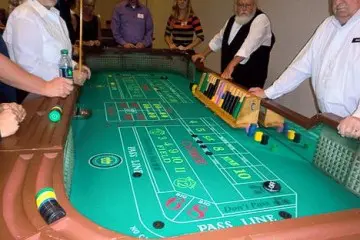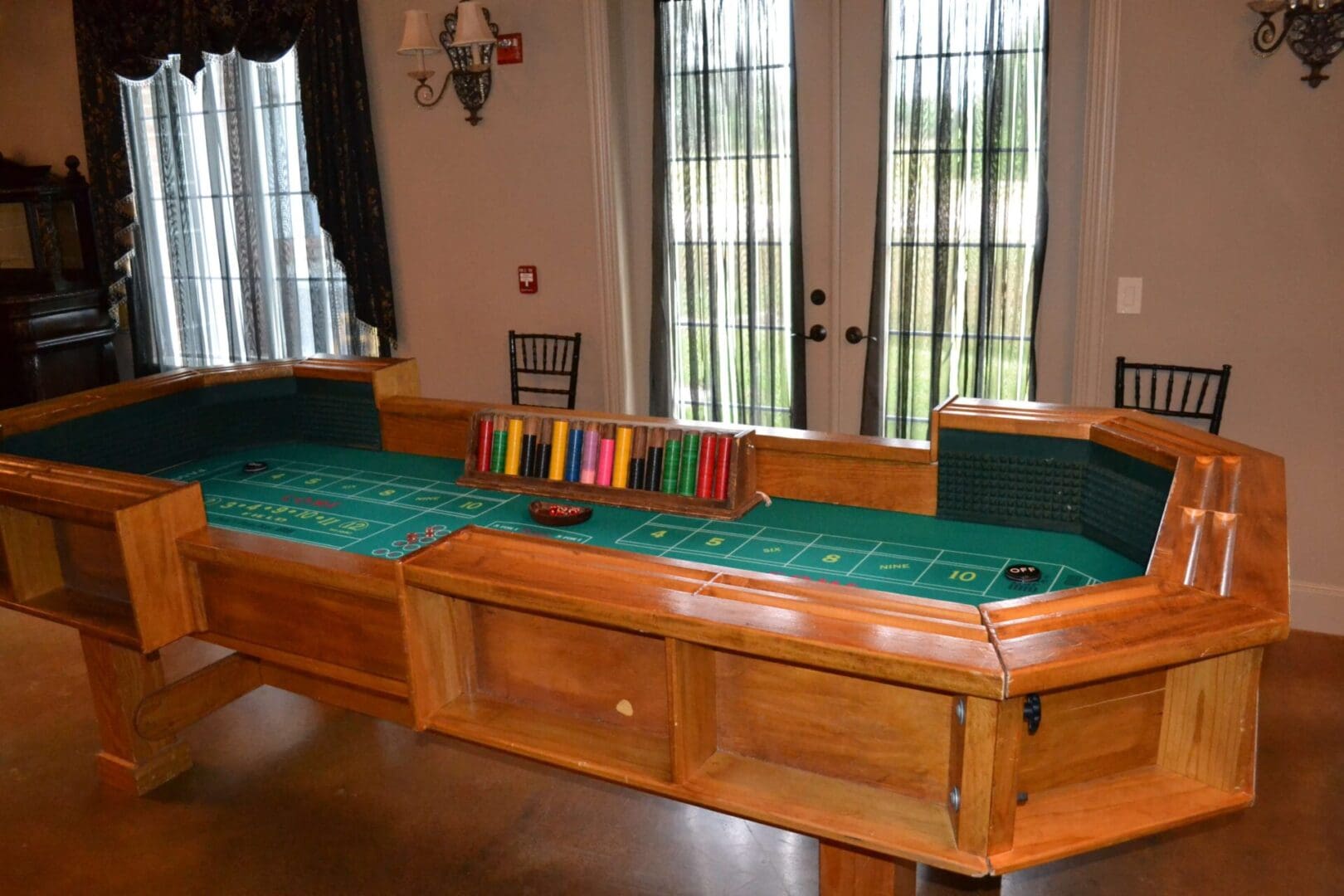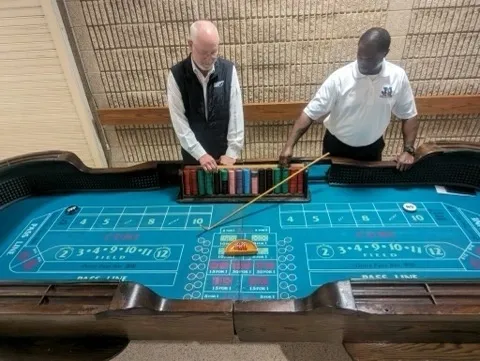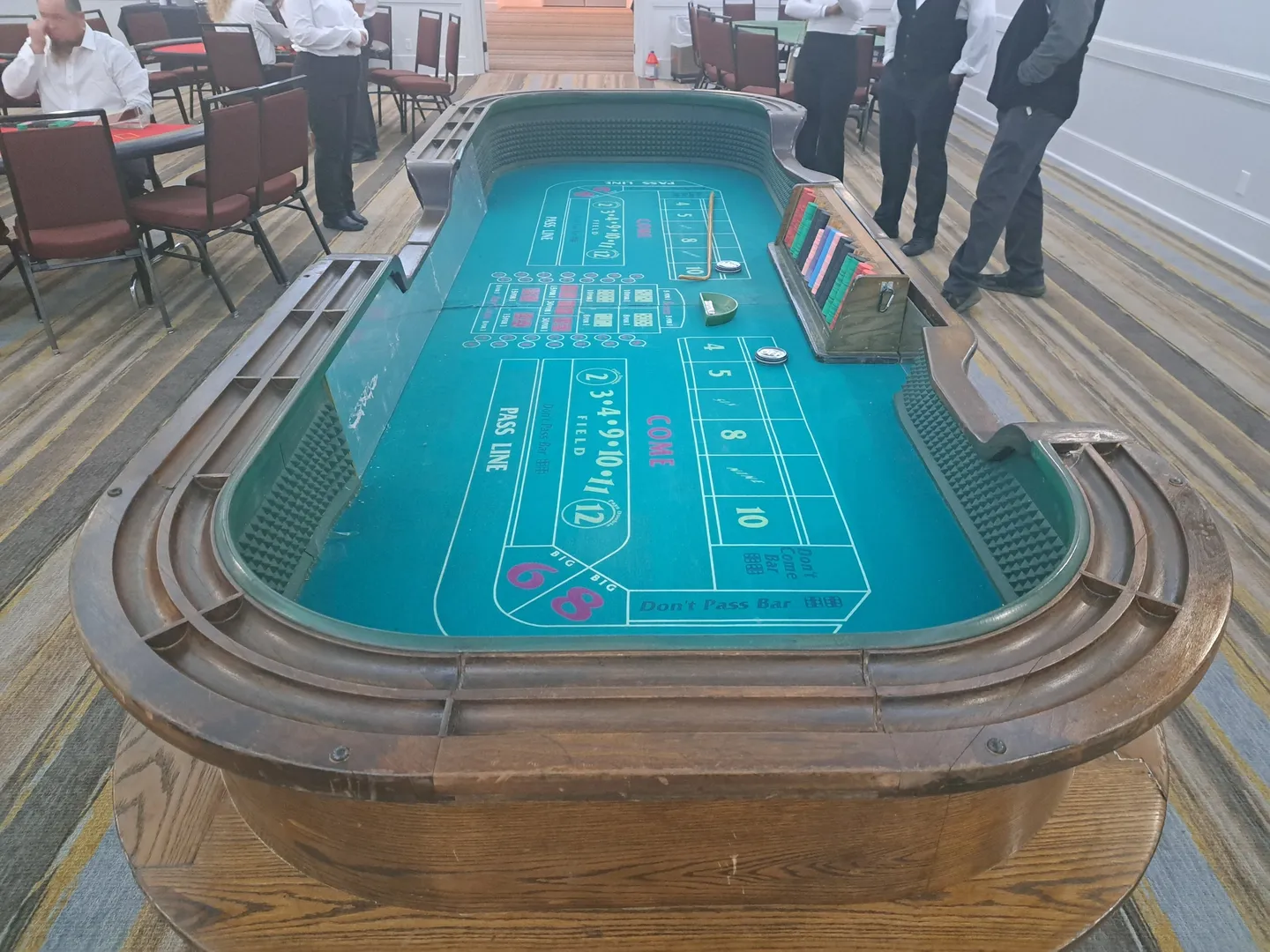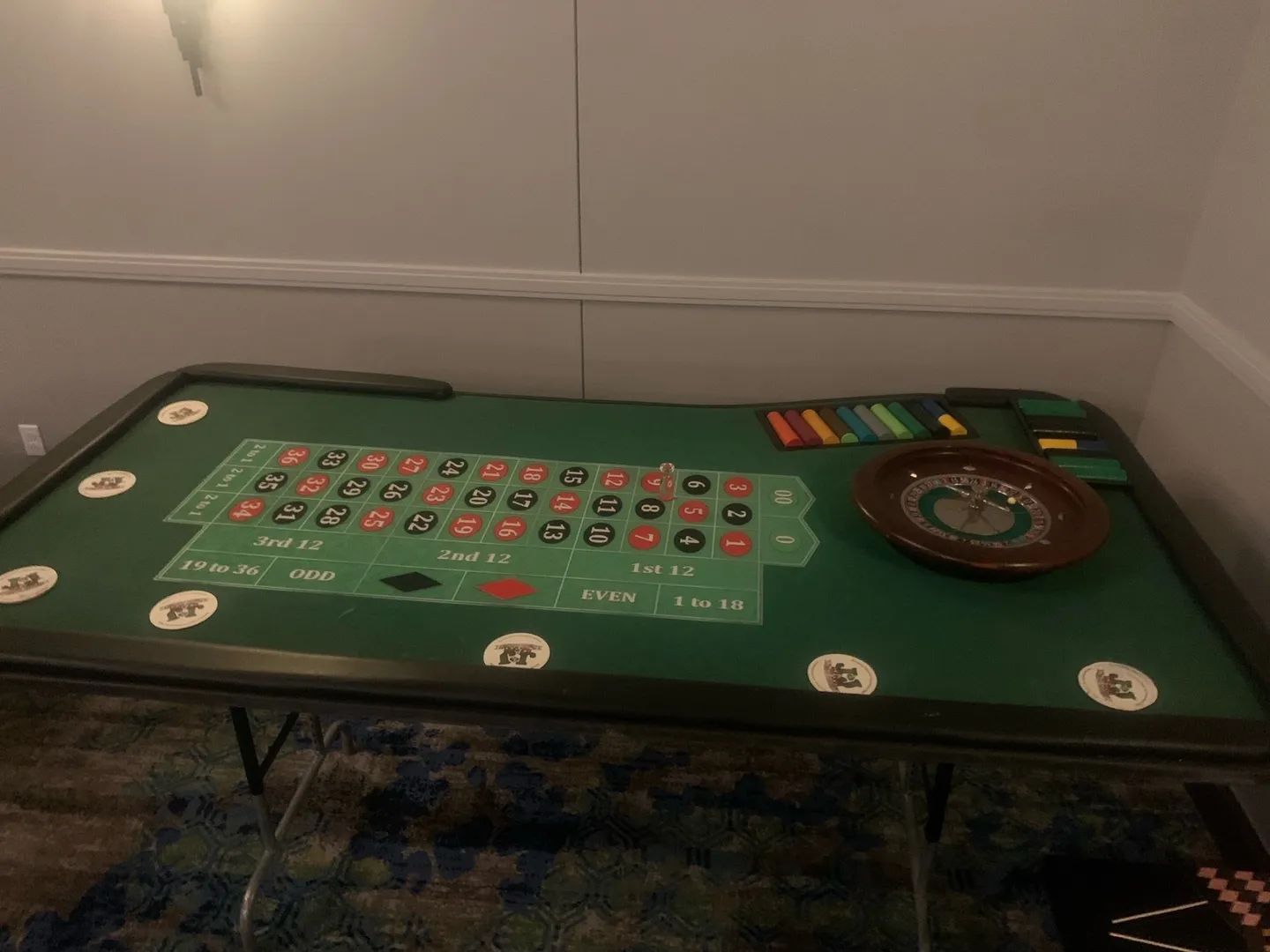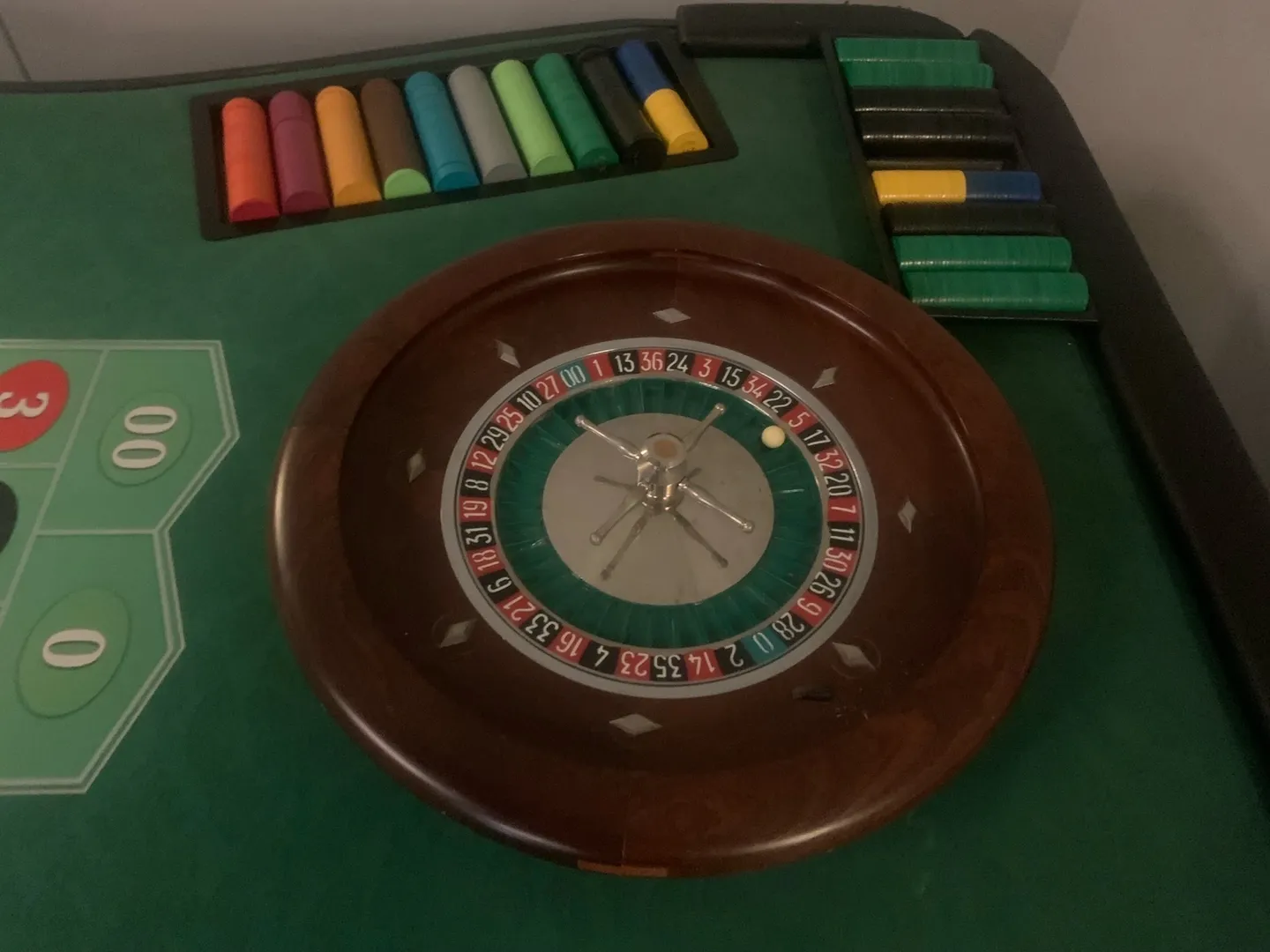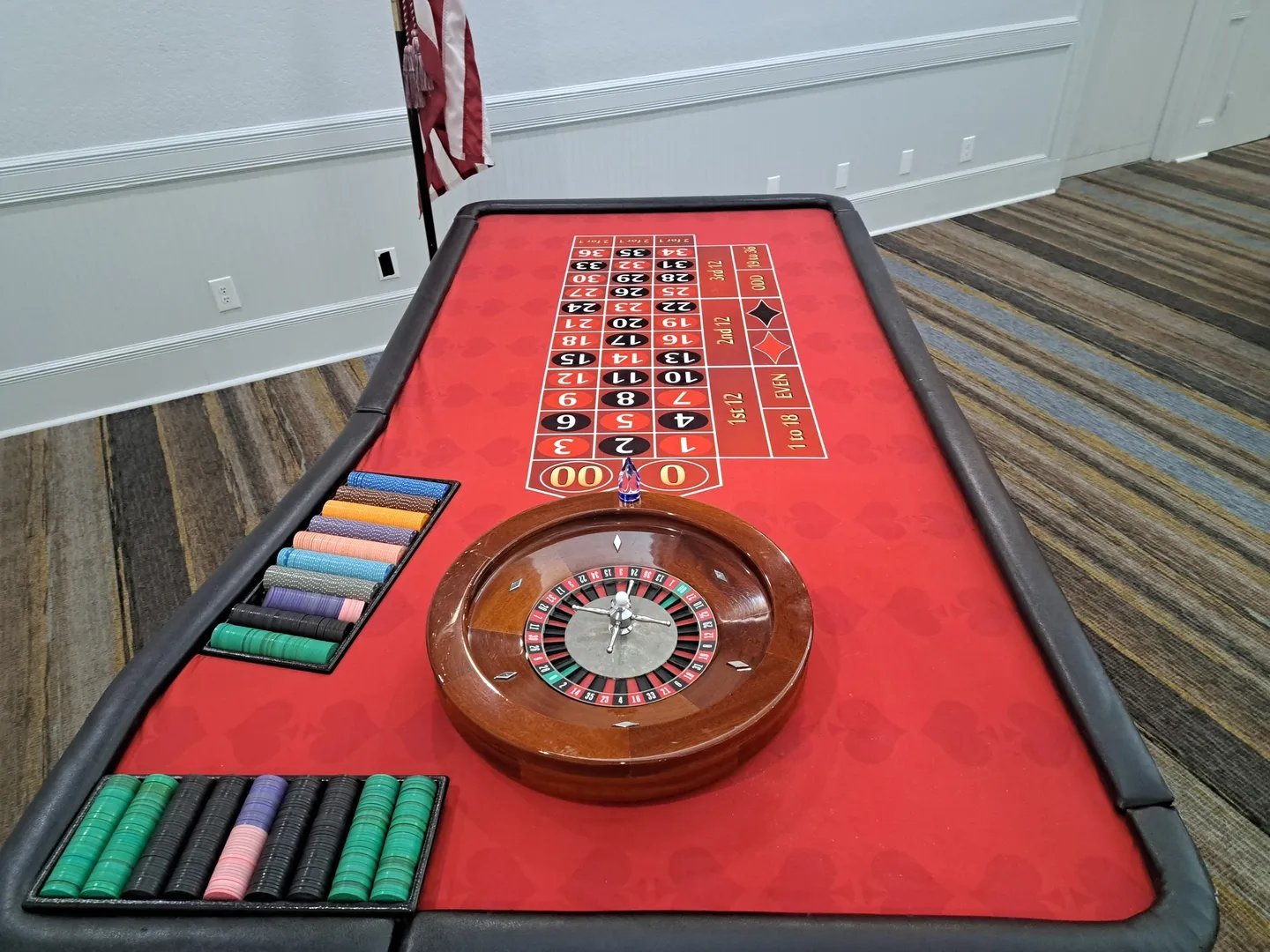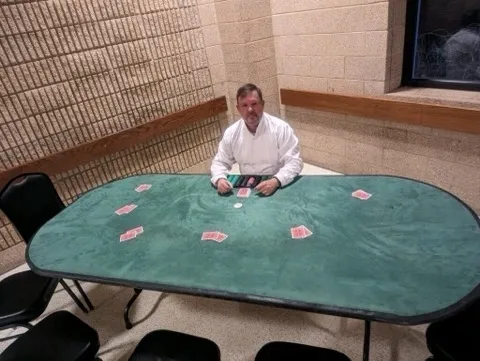Card and Table Adventures
Blackjack
Blackjack is the most popular of all Casino games. Dealers are trained to help novice players understand the game. Tables can seat up to 7 players. Chips are included, and cards are dealt from a 4-deck shoe. Adjustable height legs allow players to either sit or stand. Chairs are usually provided by the Venue or host.
How to Play Blackjack
Players compete independently against the Dealer to be close to 21 without going over. Face cards count 10, aces are 1 or 11, and all other cards (2 – 10) are counted at face value. After players make their bets, each will be dealt two cards. The player's cards are dealt up, and the Dealer has one card up and one down. If the Dealer's up card is an ace, they will offer insurance, which is a separate bet a player can make before the Dealer looks at their card. Insurance bets win if the Dealer has 21. The bet can be up to half their original bet, paying 2 to 1. The Dealer would now look at their whole card. If the Dealer has 21, players lose the original bet, and another hand is dealt. If not, any player that has Blackjack '21' (an ace and a 10-count card) is paid double (1.5 at a real casino). Now that all insurance and 21 business are over, we can play the hand.
Beginning with the player to the left of the Dealer, each, in turn, will decide their action. They either hit or stand, or make an additional bet to 'split' (split an existing pair by making a matching bet, thus creating two separate hands to be played) or 'double down' (make an additional bet up to the original bet and receive one, and only one, additional card). Most of a player's action depends on the Dealer's up card. For example, if the Dealer has a 4, 5, or 6 showing, a player can look for opportunities to double down, or split, but regardless, not take a card that can bust them, and go over 21. There are basic guidelines to improve the chances of winning. The Dealer's up card decides the Player's action. Ask your Dealer for advice.
Once all players have acted on their hands, the Dealer reveals their down card. The dealer must stand if the total is 17 or above, and 'hit' (take a card) if it is 16 or less. After the Dealer makes their hand, they will settle each hand, starting with the first hand to their right. If a tie is referred to as a Push, neither wins nor loses.
Craps/Dice
Our Dice Tables
Dice tables are often the main attraction at casino parties. The game can be intimidating, so our dealers are trained to explain the basics and expand training as the party progresses. We have large 12-ft tables that seat up to 16 people and smaller 8-ft tables that seat 10 players. Both look great in hotel ballrooms. We also have 7ft-flat-top tables for game 7. Good for use in your home or small Venue. Tables include a wooden chip rack and accessories necessary to run the game. The larger tables require 3 dealers (like casinos), but the 7-ft and 8-ft tables only require one or two dealers to control the action.
Understanding the Dice Game Pass Line Betting
Craps/Dice is a fast-paced game offering several ways to wager on each roll of the dice. The basic bet on the table is the "Pass Line" bet, located around the outer edge of the layout. There is a button reflecting either OFF or ON. When this button shows OFF, the shooter (person with dice) is rolling the 'come out' roll (the first roll of the dice). If a seven or eleven is rolled, you win if you bet on the pass line. If a two, three, or twelve (aka 'craps'), is rolled, you lose. If either of these outcomes occurs, you can replace your bet and the same shooter will roll again.
Any other dice roll (4, 5, 6, 8, 9, or 10) will establish the 'point', and the Dealer will change the 'button' to ON and position it in the box reflecting the number rolled. To win the 'Pass Line' bet, the shooter must roll the 'point' before rolling a seven. No other number rolled affects the pass-line bet. The shooter continues to roll until they are seven out or roll the point. If the point is rolled, the process starts with the same shooter. If a seven is rolled, the dice go to the next shooter, and the process starts over.
While the shooter attempts to roll the 'point' (the number set by the first roll of the dice), each player can make several additional bets (Odds Bet, Place Bets, Come Bets, Field Bets, and Proposition Bets) that have action on every roll of the dice. When the shooter rolls a seven while trying to make a 'point' all bets lose and the Dealer clears all bets from the table. The exception is if a player is playing a "Don't Pass" bet, opposite the pass line bet. The dice pass to the next player clockwise around the table, and betting begins again with a new lucky shooter and a new 'Pass Line' bet. A shooter holding the roll for a long time is known as a "Hot shooter." Ask the Dealers for help with all the other bets, and they will be happy to help you.
Roulette
Our Roulette Tables
A roulette table often completes the casino experience, with games for up to 8 people per table. For players intimidated by the fast action of a dice table, roulette may provide the opportunity to gamble on a simple wheel spin. It is as easy as picking one of 36 numbers, or red versus black. Tables include a 19" wooden roulette wheel, various colored chips for roulette players, and accessories necessary to run the game. Our roulette tables have adjustable-height legs for players to sit or stand on. We do not provide chairs.
How to Play Roulette
Roulette, a popular European game, is played with a dealer spinning a ball around a spinning horizontal wheel with 36 numbers and two zeros. The table layout provides players a place to wager chips and try to guess where the ball will land. Each player is given a color of chips to distinguish their bets on the layout.
With each wheel spin, players are allowed to wager on several bets on a common table layout. Each player can bet on whether the ball will land on a particular number (pays 35 to 1), two numbers (pays 17 to 1), four numbers (pays 8 to 1), and others at varying payout odds. Dealers will happily show you how to place bets on the numbers. Players can also make bets on the 'outside row' — colors (red or black), groups of 18 numbers, or Even or Odd, these bets pay even money. Furthermore, the layout divides the 36 numbers into groups of 12 number sections. Players can bet on these six sections, and the odds are 2 to 1. If the ball lands on either zero, all bets lose, unless you bet on zeros.
Players can place bets once winners have been paid and the "Puck" has been picked up. Betting can continue until the ball begins to slow. The Dealer will wave over the table and say, "No more bets." Once the ball settles into a slot, the Dealer will announce the winning number and color and place a marker on that number on the layout. The Dealer will clear all losing bets and then pay winners.
Texas Hold 'em Poker
Our Poker Tables
Our Texas Hold 'em poker tables seat up to 10 players with a dealer. Although the game is very popular in Texas, Hold 'em tables are not ideal to include at casino parties. Poker players gamble against each other. They are limited to winning only other players' buy-ins.
In other games like blackjack and dice, you are gambling against the 'house,' and there is no limit on what you can win. For this reason, poker is not ideal at casino parties, where you compete against other guests to accumulate the most chips in three hours. Poker tournaments are a great opportunity to raise money for charities/softball teams/etc. Tables include accessories necessary to run the game.
How to Play Texas Hold 'em
One of the more popular poker games in Las Vegas, it is played with up to 10 players at a table with a dealer. A 'button' is moved around the table with each hand. It marks the 'dealer' and requires that the two players to the left of the button must make 'blind bets'. More will be discussed later regarding the significance of the button and how a player's decisions should be partially determined by where they sit in relation to the button.
After each player receives two cards, the player to the left of the 'blind bets' acts first and must either 'fold' their cards and risk no additional chips, 'call' the bet by committing chips equal to the player to the right, or 'raise' the bet by committing additional chips to the pot. Each player will turn clockwise around the table, after everyone has folded or called and the 'pot is right', the Dealer will put three cards face up on the table (the 'flop'). A second round of betting will begin with the player left of the button, and once every remaining player 'acts' and the 'pot is right', the Dealer will turn a fourth card (the 'turn'). A third round of betting, and then the Dealer will turn a fifth and final card (the 'river'). The final round of betting will begin, and players reveal their cards. Using the five community cards and their two cards, the best poker hand wins the pot. The button is moved one position to the left, blinds are made, and cards are shuffled for another hand. If during a hand, a player bets and no player calls, then the bettor immediately wins the pot.
Ranking of Poker Hands
- Straight-Flush – five cards in a row that are the same suite
- Four-of-a-kind – four cards that are the same number
- Full House – three-of-a-kind and one pair
- Flush – five cards of the same suite
- Straight – five cards in a row, regardless of the suite. Ace is high or low.
- Three-of-a-kind – three cards of the same number
- Two Pairs – two cards with the same number and another two with a different number
- One Pair – two cards of the same number
- Ace High – to prevent ties, the highest card wins. Ace is high.
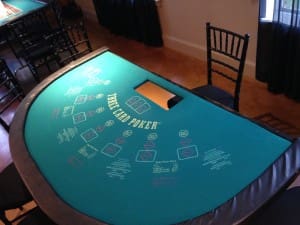
Three Card Poker
How to Play Three-Card Poker
This game consists of three bets: the 'Ante' bet, the 'Play' bet, and the 'Pair Plus' bet. Before any cards are dealt, players must bet the 'Ante' bet. An optional bet is the 'Pair Plus' bet. Simply stated, a pair wins even money on this bet; a flush pays 3-1; a straight pays 5-1; three-of-a-kind pays 30-1 and a straight flush pays 40-1. After the 'Ante' and 'Pair Plus' bets are placed, each player and the Dealer will be dealt three cards down. After looking at the cards, each player must decide to either fold (surrendering both 'ante' and 'Pair Plus' bets) or the player can make a 'Play' bet to remain in the hand. It is suggested to play when the player has Q-8-x or better. After each player has acted, the Dealer will reveal their cards, and they must have a queen or better to qualify. If the Dealer qualifies, players win both 'ante' and 'play' bets if they have a better poker hand than the Dealer. If the Dealer does not qualify, the player wins only the ante bet. The pair plus bet is based on only the player's three cards and is thus paid regardless of the dealer qualifying.
How to Play Let It Ride Poker
This game is based on a five-card poker hand. Players do not play against each other or a dealer. The object is for the player's hand to be a pair of 10s or better. Each player places three equal bets and receives three cards. Two cards are dealt face down in front of the Dealer, which is common to all players. After looking at the first three cards, the player has the option to take back one of his bets or 'Let It Ride'. Then, one of the Dealer's cards is turned over, and the player again has the option to take back the final bet or 'Let It Ride'. The other Dealer's card is then turned over, and the Dealer pays all winning hand. The better the hand, the better the payoff odds. A pair pays even money; two pairs pay 2 to 1; three-of-a-kind pay 3 to 1, etc.
Below is the complete payout schedule showing the odds:
The best strategy is to let the first bet ride when the first three cards are the same suit, all 10s and above, or any pair. Let the second bet ride with a working flush or straight, and take it back if the pair does not improve or is not 10s or better.
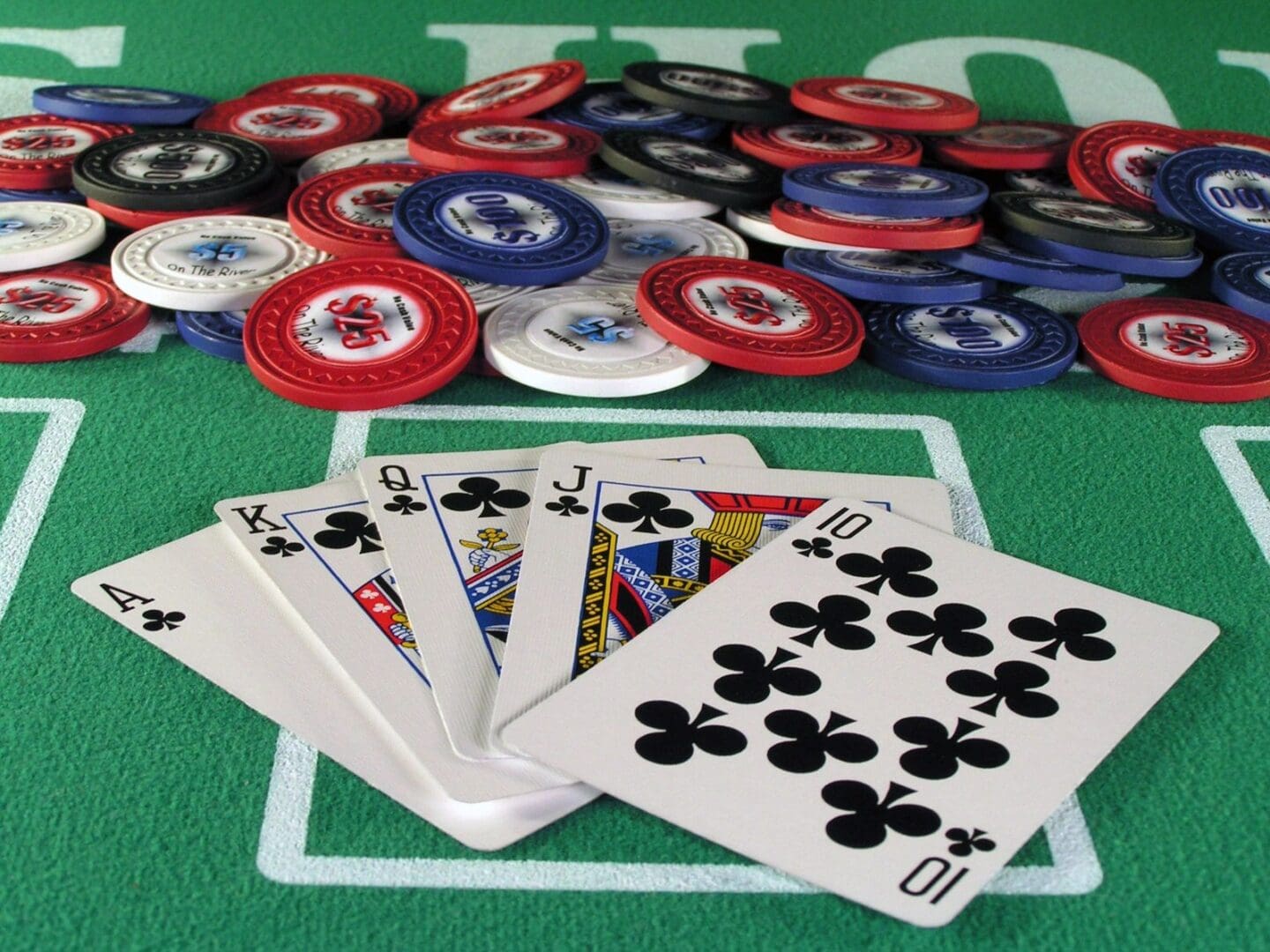
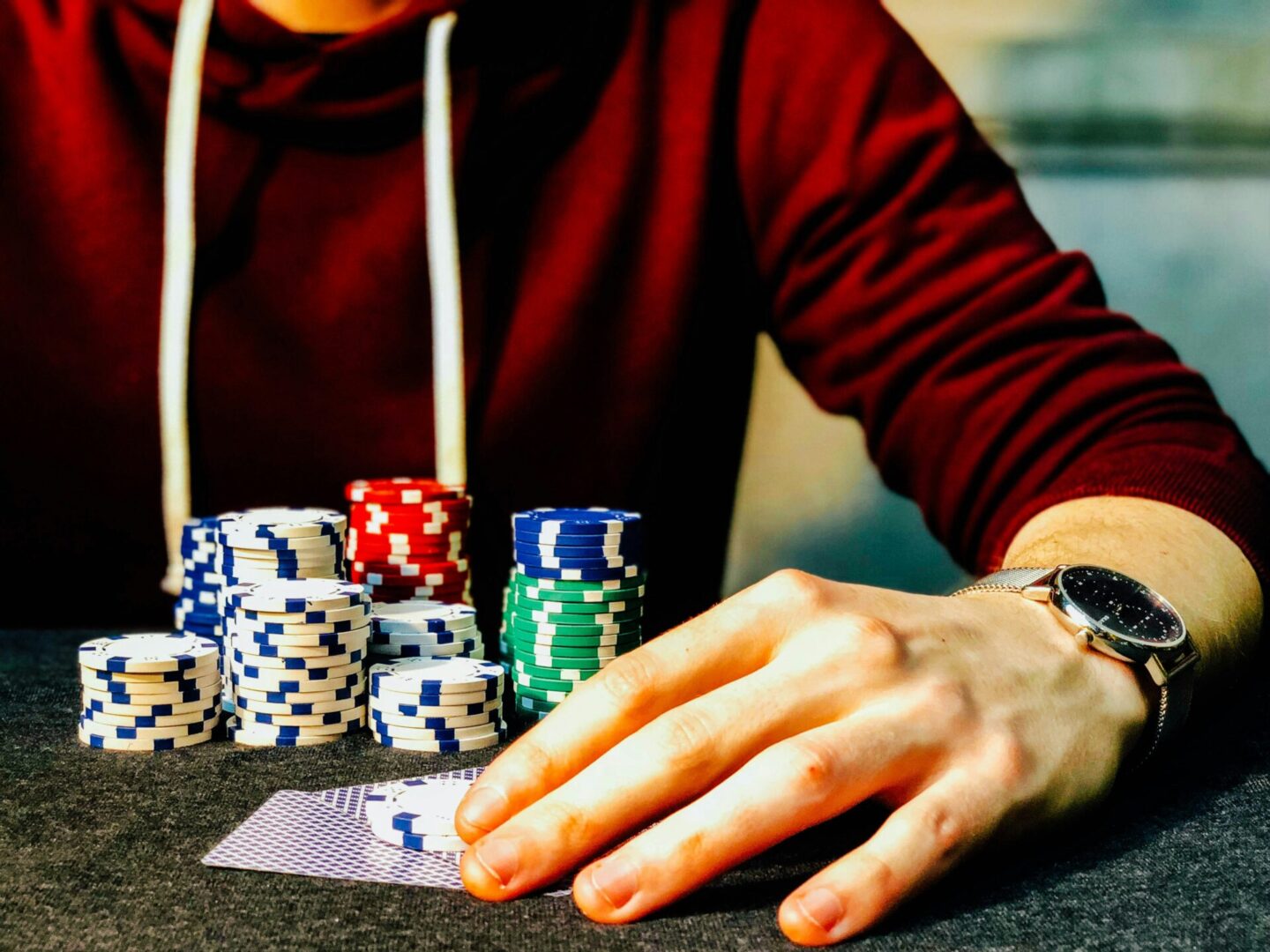
Caribbean Stud Poker
This is also a five-card poker game, with the player and Dealer receiving a hand. In this game, each player's hand must beat the Dealer's hand to win. To begin, players must make a bet in the "Ante" box. The Dealer will deal five cards to each player face down, and to himself five cards with one turned up. The players, after looking at their cards, decide to play or fold. To play, a bet twice the Ante must be made in the "Bet" box. After all players have made their decisions, the Dealer reveals his four remaining cards. The Dealer's hand must be an ace and a king or better to qualify. If they qualify, players must beat the Dealer to win "Ante" and "Bet". If the Dealer does not qualify, then all playing hands win even money on their "Ante" and push on the "Bet". Qualified winning hands are paid odds on the "Ante" bets, starting with even money for a pair to 7-1 for a full house and 100-1 for a Royal Flush. Below is the complete payout schedule showing the odds and Bonus payouts:
| ( X’s Bet) | Bonus | |
| Royal Flush | 100 | 50,000 |
| Straight Flush | 50 | 10,000 |
| Four-of-a-kind | 20 | 5,000 |
| Full House | 7 | 2,500 |
| Flush | 5 | 1,000 |
| Straight | 4 | |
| Three-of-a kind | 3 | |
| Two pair | 2 | |
| One pair or less | 1 |
The best strategy is to play any time you have a pair or better. May sound complex, but it’s not, ask the Dealer for help.

